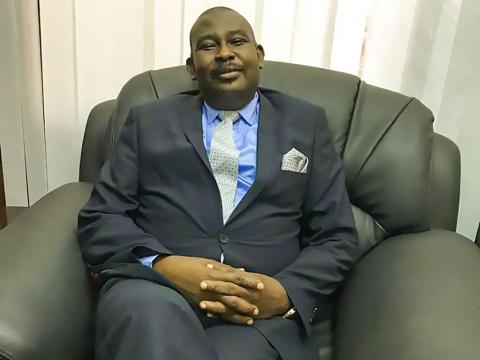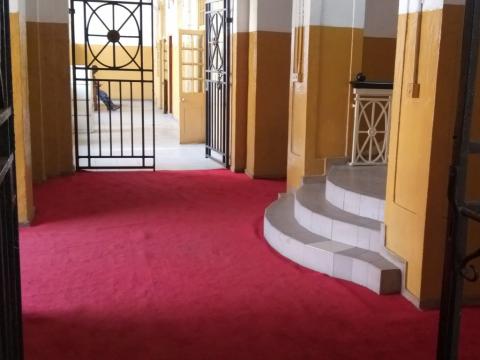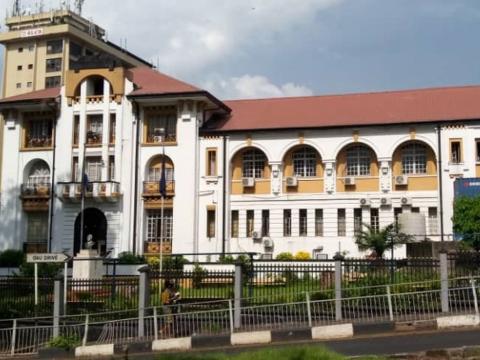By Francis H. Murray
The judiciary of Sierra Leone, one of the three arms of government, has been undergoing some massive face-lifting and reformation over the last two years, under the leadership of Chief Justice Desmond Babatunde Edwards.
Appointed by President Julius Maada Bio in December 2018, after the general elections, Chief Justice Edwards has so far been engaged in transforming the judiciary in order to match with international best practices.
The reforms run from infrastructural upgrading, to increase in access to justice, and expansion of the court system, as well as staff capacity building.
When Justice Edwards took over the judiciary, it was jam-packed with cases involving both the magistrate court and the high court. That created untidy and confusing scenes around the court building. Edwards decided to separate both courts and transferred all magistrate courts hearings to Pademba Road and other parts of the city.
This ongoing decentralization process of the justice system has been seen by many to have brought sanity to the court system, especially the main Law courts building on Siaka Stevens Street in Freetown, which hosts the High Court, the Court of Appeal and the highest Court of the land - the Supreme Court.
A frequent visitor to the High Court in recent times would have noticed that serious renovation work is going on there. Abandoned rooms over the years have been transformed into court rooms, and some used for other purposes.
The electrification of each court room, painting, as well as the installation of air conditioning has been ongoing. A long-abandoned entrance that is situated just opposite the Cotton Tree has been refurbished to serve as reception of the High Court; it entails a client’s support office and a waiting area, fitted with as intercom link to every court room in the entire building.
A waiting room is being provided to serve all the court rooms and an information desk has been erected where inquiries are to be made and possible directions given to visitors.
The newly rehabilitated air-conditioned waiting room provides sitting accommodation for up to fifty people at a time. The store just outside the main building has been renovated to house exhibits and other items.
Not only has the current Chief Justice ensured the comfort of visitors, but judges too. The chambers of all judges at the main court building are being renovated and furnished with modern office chairs, tables and rugs.
The administrative offices within the court precinct are also undergoing rehabilitation, ranging from the civil and criminal registries, Supreme Court registry and other offices. All court rooms as well as administrative buildings have been appropriately labeled to ensure easy identification.
Speaking at the Annual Bar Association Conference in Kenema, Justice Edwards highlighted some of his major successes which he said included the expansion of the High Court’s 5 divisions to eight, with the addition of the Industrial & Social Security Division, the Anti-Corruption Division and the Sexual Offences Division.
‘‘Since I took up office, I do recall that one of my first changes was to use Constitutional Instrument (C.I.) No. 4 of 2019 to divide the High Court into eight (8) Divisions. Hitherto, there were only five (5) Divisions and while these five divisions existed, they were only in name with no Special Assignment of Judges to those divisions. However, pursuant to the High Court Divisions Order, C.I. No. 4 of 2019, three (3) completely New Divisions were created with the Property Division and the Admiralty and Commercial Division transformed to a Lands, Property & Environment Division and the Fast Track Commercial Court Division respectively,’’ he told members of the Bar.
On the 9th of December 2019, the Social Security Courts were established and so too was the Anti-Corruption Courts, while on the 24th July 2020, the Sexual Offences Model Court (SOMC) was launched.
These courts are unique in themselves in that they have independent registries.
The impact of the Social Security Court is that it punishes impunity. Its impact is already being felt, amidst reports of a marked improvement in the way employers pay social security contributions for their staff.
With the establishment of the ACC Court, more cases are now completed within a short time than before.
The establishment of the Sexual Offences Court came amid the expression of outrage from members of the public against the rise in sexual offenses in recent times, for which there were calls on the judiciary to take drastic steps to speedily try all sexual offense cases and bring the culprits to justice.
In explaining the reasons for its establishment, Justice Edwards said at the Kenema occasion that it came about as a result of the numerous difficulties victims and witnesses faced in testifying about the ‘‘intricate’’ details of sexual offences and their vulnerability either by age or fear of stigmatization.
The objectives of the court are to provide effective victim-witness support services that will reduce trauma, eliminate secondary victimization, increase victim’s cooperation and attendance at the trial, and ensure the timely conclusion of matters,’’ he explained.
The court provides for witnesses to testify behind a curtain alongside support persons from an enclosed witness box, which is meant to prevent eye contact with the accused. There is also waiting room facility where support persons engage and prepare victims and witnesses prior to their testimony. There is an information center for sexual and gender based violence cases, among others.
At the Bar’s AGM, CJ Edwards admitted that at the time he took over as head of the judiciary, there were institutional weaknesses in the administration of the judiciary and that the overall administration was overburdened and weak.
‘‘Apart from the Master and Registrar (M&R) and Deputy Master who were graduates, we had only one graduate in the entire administration. The workload was concentrated in the hands of the then Master & Registrar who had some accounting deficiencies and lacked the capacity for a vote controller and had to combine court operations with judicial professional support,’’ he narrated.
In a bid to enhance the functional effectiveness and efficiency of its staff in the discharge of their duties, the Judiciary of Sierra Leone conducted a one-week training of its staff for the first time last month. The training covered the roles and responsibilities of court registrars, bailiffs, court secretaries in both civil and criminal proceedings, treatment of vulnerable or special witnesses, and bail/bond regulations and requirements.
Edwards also admitted that there was no registrar to the Supreme Court or the Court of Appeal, and that they lacked an operations manager, human resource manager, procurement & logistics manager and chartered certified accountant, all of which he said made administering the judiciary very daunting. He disclosed that his administration has filled in all the administrative deficiencies with the creation of separate court operations, different from judicial professional support, and he has appointed key officers, most of whom not only have degrees, but also post graduate qualifications.
According to the CJ, three criminal sessions of the High Court had been successfully organized and conducted under his leadership and under the umbrella of the judiciary from its budgetary allocation by the Government of Sierra Leone.
‘‘Criminal Sessions are appointed and held in areas where there are no sitting judges and until 2019 and since 1965, were held only in Port Loko, Sefadu and Moyamba. Under my leadership such sessions have been more frequent than over the years. Sefadu - Kono is now a Resident area where the Courts sits as the same time as in Freetown, Bo, Makeni and Kenema. But over and above that, High Court criminal sessions are now being held pursuant to the Appointments of High Court Criminal Sessions Ordinance 2019 in New Areas such as Kailahun (twice), Kabala (twice), Mattru-Jong (twice), Pujehun (twice), Magburaka (Tonkolili) just recently, apart from Port Loko and Moyamba,’’ he stressed.
He went on to note that while the current situation of holding High Court criminal sessions is ameliorating the gap in access to justice nationwide, which is certainly not the best possible solution, plans were ongoing for the hosting of resident judges for the very first time in Moyamba, Port Loko, Kabala, Kailahun and the York/Waterloo axis, so as to further address the issue of Access to Justice. The Judicial and Legal Service Commission (JLSC) recently appointed thirty-one (31) State Counsels and there are plans for the appointment of more judges.
Justice Edwards encouraged members of the Bar to give their full support to his administration, which he said intended to replicate the “excellent” reforms in Bo, Port Loko, Kenema, and Kailahun by next year.
Pa Mohamed Yimba Marah, one of the longest serving staff of the judiciary, described the reforms as “transformational”, and said it’s the first of its kind in the judiciary.
Pa Marrah has worked at the judiciary for over a decade. He ushers in judges into their court rooms, in addition to numerous symbolic roles he plays.
‘‘I have served the judiciary for the past 18 years and I’ve never seen this kind of discipline instilled in the staff over the past two years, which is reflected even in the reporting time for work. Now there’s accountability, because you sign the attendance book to indicate the reporting and departure time,’’ he told Politico.
Copyright © 2020 Politico Online










